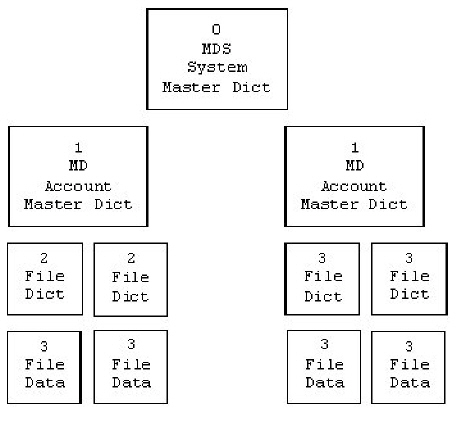search-system command
The search-system BASIC program searches every file in the D3 file system for the existence of one or more strings of characters in any attribute and optionally creates and saves a list. If a master dictionary name is provided, only that account is searched. The search-system command searches remote accounts (Q-pointers) in the mds.
Syntax
search-system {destination.file} {(options)}
Synonym(s)
find2
Parameter(s)
| options | ? | Displays online usage information about the process. |
| a | Displays all items searched, including items in which the string was not found. | |
| c | Clears the output file prior to execution. | |
| m | Checks for multiple occurrences. | |
| p | Directs output to the system printer via the spooler. | |
| s | Suppresses display on the screen. | |
| q | Searches remote accounts and files. |
The search-system command scans each item in each file looking for a string match in any attribute. If a match is found, it displays the item-ID, and the attribute containing the matching string. Any number of unique strings may be specified. The search is successful if any one string matches any portion of the attribute.
This process prompts with these messages:
Enter the output file name?
Enter the name of the file where the found items are saved (it must already exist). As items are found, control items are added to the output file, using sequentially-assigned numeric item-IDs beginning with 1.
Enter the search string?
Enter the string without any enclosing delimiters. The system repeatedly asks for additional strings. A question mark can be used as a wildcard character in the string (up to 15 different strings can be specified).
The question mark can be used as a wildcard search character. To locate a string that contains a question mark, type ??. After the last string has been entered, press ENTER at the ...string? prompt, advances to the next prompt.
Start level 0-mds, 1-master dictionary, 2-file dictionary, 3-data file?
The example above tells the process at which level of the file system to begin the search. The search-system command has hierarchical level control. The four levels are:
-
mds
-
md
-
dict file
-
data file
Any range can be specified. A data file search can also be specified to search system-wide horizontally. Enter the level to begin the search.

Next, the system asks either:
Stop Level 0-mds, 1-master Dictionary, 2-file Dictionary, 3-data File?
or
Lateral Level 0-mds, 1-master Dictionary, 2-file Dictionary, 3-data File?
This is the level to continue the search. The routine can either traverse a single branch of the hierarchy (such as a single account and all its files) or it can traverse laterally across the branches (such as all the data files only of all the accounts). The stop/lateral level must be equal to or lower than the start level.
Output is an item of the format:
001 mds (account name) 002 dict, data file name 003 item-ID 004 attribute number in which text was found 005 attribute text 006 the search string
See also
compare command, find command, find2 command, search command